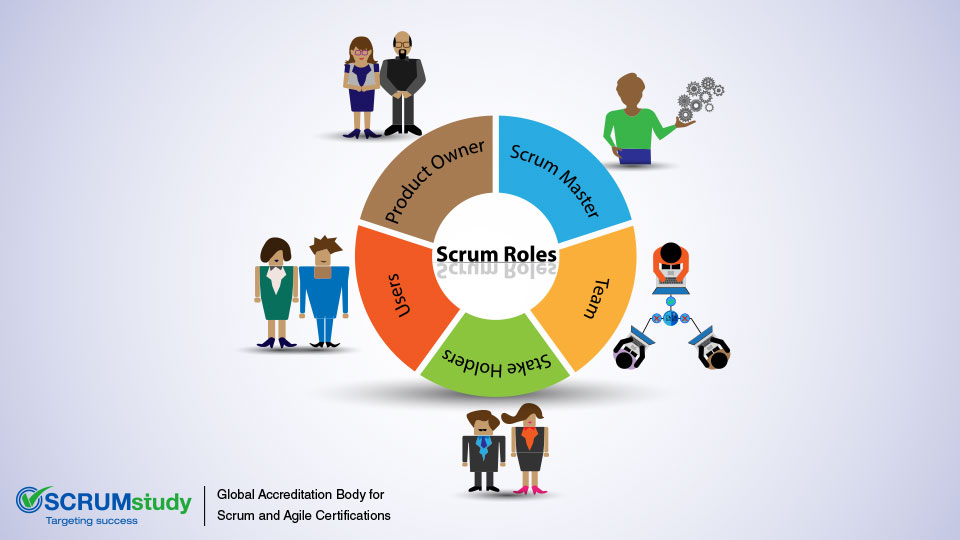Non-core Roles in Scrum
Posted bySCRUMstudy® on January 29, 2023
Categories Agile Product Owner SBOK® Guide Scrum Master Scrum Team
The non-core roles can be described as those roles that are not mandatorily required for the Scrum project and that may not be continuously or directly involved in the Scrum process. However, knowing non-core roles is important as they can play a significant part in Scrum projects.
Non-core roles can include the following:
1. Stakeholder(s)
core roles include the following:
- Business Stakeholder(s) —Business stakeholder(s) is a collective term that includes customers, users, and sponsor(s), who frequently interface with the Product Owner, Scrum Master, and Scrum Team to provide them with inputs and facilitate creation of the project’s product, service, or other result. Business stakeholder(s) influence the project throughout the project’s development. Business stakeholders may also have a role to play during the Develop Epic(s), Create Prioritized Product Backlog, Conduct Release Planning, Retrospect Sprint, and other important processes in Scrum. Scrum requires complete support from the project’s business stakeholders.
- Customer -The customer is the individual or the organization that acquires the project’s product, service, or other result. For any organization, depending on the project, there can be both internal customers (i.e., within the same organization), or external customers (i.e., outside of the organization).
- Users - Users are the individuals or the organization that directly uses the project’s product, service, or other result. Like customers, for any organization, there can be both internal and external users. Also, in some industries customers and users may be the same.
- Sponsor -The sponsor is the individual or the organization that provides funding, support, and other resources for the project. The sponsor is also the business stakeholder to whom team members are ultimately accountable to.
2. Vendors
Vendors include external individuals or organizations that provide products and services that are not within the core competencies of the project organization. At times, the same person or organization can play multiple business stakeholder roles; for example, the sponsor and the customer may be the same.
3. Scrum Guidance Body
The Scrum Guidance Body is an optional role. It generally consists of a group of documents or a group of experts who are typically involved with defining objectives related to quality, government regulations, security, and other key organizational parameters. These objectives guide the work carried out by the Product Owner, Scrum Master, and Scrum Team. The Scrum Guidance Body also helps capture the best practices that should be used across all Scrum projects in the organization.
The Scrum Guidance Body does not make decisions related to the project. Instead it acts as a consulting or guidance structure for all the hierarchy levels in the project organization—the portfolio, program, and project. Scrum Teams have the option of asking the Scrum Guidance Body for advice as required.
Core and Non-core Roles in Scrum
Posted bySCRUMstudy® on September 12, 2022
Categories Agile Iterative Development Product Owner SBOK® Guide Scrum Scrum Guide Scrum Team
Central to the success of a Scrum project are the people or employees working on the project, and coordination between them. To ensure coordination and harmony within the scrum team, it is necessary to clearly define the roles and responsibilities of the Scrum team members.
In Scrum teams, roles are divided into two main categories: Core Roles and Non-core Roles. This classification is clearly outlined in the SBOK Guide published by SCRUMstudy and is based on the roles' impact on the success of a Scrum Project.
Core Roles in Scrum directly contribute to the project's success. These roles are responsible for producing deliverables in each sprint that meet the acceptance criteria, thereby ensuring the overall success of the project. Core roles have formal responsibilities within the Scrum team.
Non-core Roles in Scrum do not directly impact the project's success, but they have a vested interest in the project and its outcomes. While these roles are not held accountable for sprint or project failures, their perspectives should be considered as they have a stake in the project's outcome. Each of these roles is further classified as mentioned below.
Core Roles:
- Product Owner – Project Owner represents the voice of a customer. He is responsible to understand the customer requirements and articulate the same to the scrum team. He is also responsible to deliver maximum business value to the customer. He defines the acceptance criteria for the deliverables.
- Scrum Master – Scrum Master is responsible for removing the impediments faced by the scrum team members and facilitate the team in developing the deliverables. He also sees to it that the team is working in harmony and work towards attaining the defined goals.
- Scrum Team/ Development Team – Scrum team or the Development team is responsible for the production of goods and services that meet the acceptance criteria. The scrum team is responsible for the success or failure of the project as it is directly involved in the production.
Non-core roles:
- Stakeholders – Customers, Users, Sponsors are the stakeholders in the scrum project who have interest in the outcome of the project but are not directly involved in the sprints for productions.
- Vendors – Vendors or the suppliers are the one who deliver the semi-finished products that go into the final production of the deliverable by the scrum team.
- Scrum Guidance Body – As defined in the SBOK Guide, scum guidance body is a group of people of set of documents that define the quality criteria, government rules and regulations, etc. that affect the performance of the scrum team.
The above discussed core and non-core roles in scrum projects are responsible directly or indirectly for the success of a sprint and the deliverables of each sprint. Hence, it is necessary to understand each of these roles and define their responsibilities and authority.


